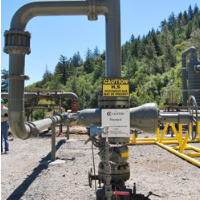33 More Oil Injection Wells Closed for Pumping Wastewater into Aquifers
 Fracking waste injection well (photo: Flickr-kqedquest)
Fracking waste injection well (photo: Flickr-kqedquest)
The U.S. Environmental Protection Agency (EPA) gave the state “primacy” in 1983 to regulate oil and gas injection wells that pump toxic wastewater from drilling operations into the ground, with the understanding the muck doesn’t end up in federally-protected aquifers.
A year ago, when it was discovered that California’s Division of Oil, Gas and Geothermal Resources (DOGGR) didn’t really monitor the state’s injection wells, 23 were shut down and a survey of the other 50,000 commenced at the behest of the EPA. DOGGR is in the California Department of Conservation.
Last week, another 33 were shut down. All but two of them were in Kern County. Twelve of the wells were already inactive, but the other 21 were injecting wastewater where they shouldn’t. The two wells outside of Kern County were in Ventura County’s Sespe field and Los Angeles County’s Newhall field.
“This is part of our ongoing effort (pdf) to ensure that California’s groundwater resources are protected as oil and gas production take place,” DOGGR supervisor Steven Bohlen said in a self-congratulatory statement. “The regulations are working. We’re on track to do what we set out to do in establishing an aggressive compliance schedule with the US EPA and State Water Resources Control Board.”
That “aggressive” schedule was crafted after the EPA helped clear up a misunderstanding with the state over which aquifers drillers couldn’t dump their wastewater in or near. The feds had provided a list of aquifers in the state that were exempt from the federal Safe Drinking Water Act and could be used for injection.
But apparently the state’s copy of the agreement listed 11 more exempt aquifers than the fed version. “We cannot tell, nor can the EPA, which version is correct,” Bohlen told the San Francisco Chronicle in February.
More wells could still be closed. Around 2,500 were initially found in the survey to either have an improper permit or none at all. The state admits it handed out 500 permits it shouldn’t have, but is giving well operators a two-year opportunity to plead their case for an exemption.
“Unless exemptions are granted, injection into 11 geologic zones historically treated as exempt from the Safe Drinking Water Act must cease by December 31, 2016,” the Conservation Department said in its release announcing the 33 closures. “Injection into all other non-exempt zones with water quality of less than 10,000 TDS [total dissolved solids] must cease by February 15, 2017.”
The oil industry’s chief lobbyist, the Western States Petroleum Association, argues the point that, so far, no one has found pollution levels in the effected aquifers to be unacceptable. But not everyone wants to make that the benchmark for action.
“This outrageous plan could permanently destroy scores of California aquifers,” Center for Biological Diversity staff attorney Hollin Kretzmann said in a statement last April when DOGGR made clear its intention to cut drillers some slack until 2017.
–Ken Broder
To Learn More:
State Closes 33 More Oil Field Injection Wells (by John Cox, Bakersfield Californian)
State Shuts 33 Wells Injecting Oil Wastewater into Aquifers (by David R. Baker, San Francisco Chronicle)
Aquifer-Polluting Oil Industry Injection Wells to Be Closed, Maybe, Starting in Six Months (by Ken Broder, AllGov California)
More Underground Injection Wells Close as California Moves to Protect Groundwater (California Department of Conservation) (pdf)
- Top Stories
- Controversies
- Where is the Money Going?
- California and the Nation
- Appointments and Resignations
- Unusual News
- Latest News
- California Forbids U.S. Immigration Agents from Pretending to be Police
- California Lawmakers Urged to Strip “Self-Dealing” Tax Board of Its Duties
- Big Oil’s Grip on California
- Santa Cruz Police See Homeland Security Betrayal in Use of Gang Roundup as Cover for Immigration Raid
- Oil Companies Face Deadline to Stop Polluting California Groundwater





